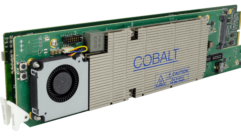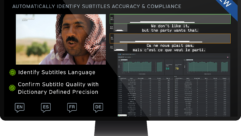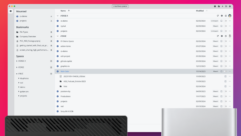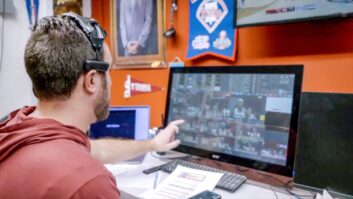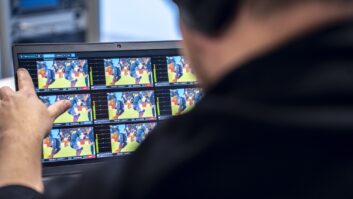NAB 2007 Review
This year’s NAB show was relatively quiet when it came to news of breakthrough products. But there was no missing the impending digital TV transition, not with all of the posters, signs, handouts, and booths that prominently featured ?Feb. 17, 2009? on them.
This year’s NAB show was relatively quiet when it came to news of breakthrough products. But there was no missing the impending digital TV transition, not with all of the posters, signs, handouts, and booths that prominently featured “Feb. 17, 2009” on them.
In that spirit, both Samsung and LG/Harris hosted mobile DTV reception demonstrations based on the ATSC VSB modulation standard. Samsung’s A-VSB demo rode on an 8VSB broadcast from Sinclair DTV station KVMY-22, and required 5.3 Mb/s to transmit two mobile video streams.
The first stream was KVMY’s main program, recoded as MPEG4 with QVGA resolution (160×120). It had a bit rate of 2 Mb/s, using “turbo” half-rate coding for viewing at highway speeds.
The second stream was custom MPEG4 video content, also streamed at 2 Mb/s using “turbo” ¼-rate coding and intended for reception aboard high-speed trains. In addition, a 1.2 Mb/s (10 byte) supplementary reference signal (SRS) was broadcast as part of the main SDTV 8VSB stream to ensure that all A-VSB receivers used in the demo stayed locked onto the transmission. Diversity antennas were used to receive all three signals.
The LG/Harris MPH demo didn’t use SRS or diversity antennas and was broadcast from another Sinclair station, KVCW-29. 4.4 Mb/s of the total ATSC stream was divided between two QVGA MPH programs, also encoded in the AVC H.264 format. The first service was a real-time mux of KVCW’s standard programming, using 1/2-rate coding at 2.2 Mb/s, while the second service provided a mix of content from a server and was ¼-rate coded, again in a 2.2 Mb/s stream. LG and Harris claim both modes will provide steady reception at speeds as high as 200 mph.
Results? Both systems worked very well for mobile DTV reception at speeds up to 70 miles per hour in high multipath environments. If anything, the MPH system has the edge in that it doesn’t need the diversity antenna system, which means MPH receivers can be a lot smaller and more portable. While the A-VSB demo worked well, the prototype Samsung receiver and antennas are too large to carry in your pocket.
On to the rest of the show: According to the official NAB press release, there were 108,322 registered attendees for 2007, up about 3,000 from last year. If so, it was hard to figure out where they were hiding. Whatever the reason for the reduced crowds, it made walking around the show much easier. As usual, I found some items of interest amongst the hype and window dressing.
One thing that surprised me as I waltzed through the rear of the central hall was the number of small interface companies present, all selling HDMI, DVI, and related digital interfaces. HDMI is first and foremost a consumer interface, but apparently there has been heightened interest from the professional sector in using it.
One such company was QVS of Romulus, Mich. In addition to numerous interface boxes, they also showed “swivel” head HDMI adapter plugs and cables for tight corners and installations. The cables are available in 6-, 9-, and 15-foot lengths, and the adapters come with various HDMI and DVI genders.
Low-cost video scaling is now the order of the day. Kramer Electronics had its $595 VP-419xl out for inspection, and it will scale NTSC, S-video, or component 480i to 480p, 576p, 720p, and 1080i, plus VGA, SVGA, XGA, and SXGA. All signals are delivered in the 15-pin VGA format.
Analog Way had two new, lower-cost scaler/switchers on display. The Easy Fade (Model EFD341) and Easy Cut (Model ESC341) combine high resolution video scaling to 1600×1200) with audio video switching. Each has four video inputs, frame conversion, and time base correction. The Easy Fade can cut or fade between a PC and any Video source, while the Easy Cut operates in cut and smooth switching modes.
Over in the Christie Digital booth, there was a clever, single-card, plug-in seamless edge blending solution (Twist) that allowed stacked portrait mode and even convex screen projection with little geometric distortion. Christie now has a range of three-chip, 1080p projectors for digital cinema and post applications, and the HD5KC (5,000 lumens) looks to be popular. It has five interchangeable lenses and uses a xenon projection lamp.
Sony finally announced a replacement for its BVM-series CRT monitors, which are no longer in production. BVM-L professional LCD monitor will be available first in the 23-inch BVM-L230, a 10-bit S-IPS display with 1920×1080 resolution, LED backlights, and advanced look-up tables to support REC.709, EBU, and DCI color spaces. A 42-inch prototype also was shown for fall delivery.
A small booth amongst the satellite hardware companies showed OEM promise. Acogito, a Korean manufacturer, had its versions of the SlingBox Internet media player on display, available as a single-tuner ATSC/NTSC/QAM receiver (ACO-210HP) and as a dual-tuner HD DVR (ACO-200HDP). A DVB version is also in the works, as are 32- and 42-inch integrated LCD HDTVs.
Communications Specialties, which has long been the lone voice for fiber in the pro AV industry, unveiled their 7500-series DVI-over-fiber transmitters and receivers. The 7500 can transmit single-link DVI signals up to 1920×1200 resolution over 10 kilometers (6.25 miles) of single-mode optical fiber, and DVI cables as long as 45 feet will work at either end.
Sencore had a few new gadgets on its counters, including an HDMI/HDCP compatibility tester. It can quickly identify a troublesome HDMI source (set-top box, receiver, DVD player) or sink (HDTV, monitor, or switcher/scaler). There was also a neat compact VSB/QAM RF analyzer about the size of a tiny lunchbox that featured a built-in color LCD screen. No price, model number, or availability yet on this piece.
There weren’t nearly as many displays to see at NAB as there had been in previous years, what with Sanyo missing, Panasonic leaving its projector group at home, and Barco concentrating on control room displays. However, there was a seminar the Saturday before the show about the new crop of display technologies: how to measure them, what the contenders are, and how much of a difference it makes to the average viewer when high-definition content is viewed as 720p, 1080i, and 1080p.
The IEEE BTS session on displays was well attended, and probably raised more questions than it answered. The fact is CRTs are pretty much gone from the professional and broadcast monitoring space, replaced with LCDs and some plasma models for direct-view setups, and rear-projection DLP and LCOS for multiple applications.
Are any of these contenders ready for prime time? Perhaps so in some applications. LCDs still have issues with black levels, viewing angles, and motion blur, although there were a few LCD monitors using fast refresh (120Hz scanning) to address the problem. Panasonic showed a 103-inch 1080p plasma monitor for “critical applications,” although it wasn’t clear what that meant.
JVC’s DLA-RS1 front projector complemented its 48-inch LCOS rear-projection studio monitor, and both had considerable eye appeal. Sony’s new 23-incher was accompanied by a bevy of LUMA LCD monitors that looked good with scenes of average to high luminance, but needed deeper blacks.
The truth is we’re still at the cusp of change when it comes to professional monitoring. There is no one perfect solution yet, and even those with great promise, such as the SED, remain mired in technological and legal delays that may eventually do them in altogether.
Still, it is interesting to see companies such as Sony, Panasonic, and JVC take the lead in advocating LCD and LCOS technologies as a replacement for the age-old CRT, and you can be sure we’ll have a lot more product to inspect at NAB 2008.
FEEDBACK
To comment on this article, e-mail the Pro AV editorial staff at [email protected].
Pete Putman is a contributing editor for Pro AV and president of ROAM Consulting, Doylestown, Pa. Especially well known for the product testing and development services he provides to manufacturers of projectors, monitors, integrated TVs, and display interfaces, he has also authored hundreds of technical articles, reviews, and columns for industry trade and consumer magazines over the last two decades. You can reach him at [email protected].



